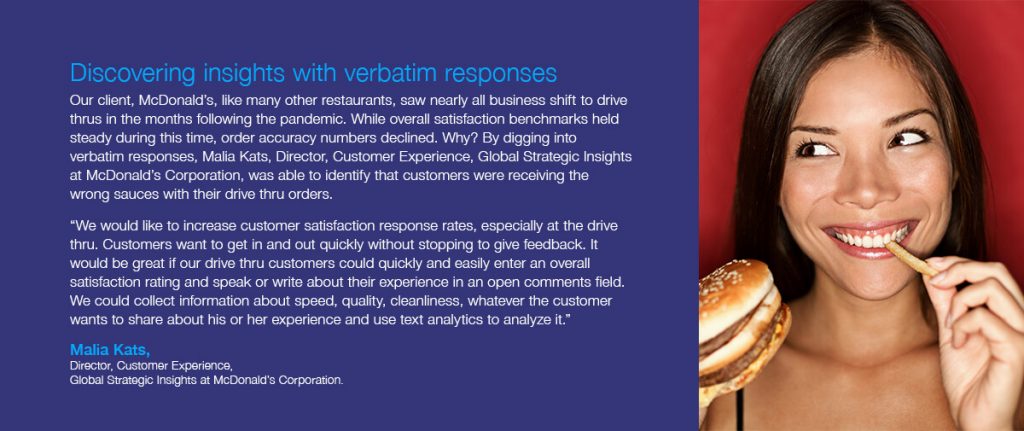
Several studies have come to the same conclusion: Improving customer experience (CX) results in higher revenues. According to a survey by The Temkin Group, investing in CX initiatives can result in 2x revenue growth within 36 months.
That’s the type of return that turns heads at an executive meeting. But what about execution? If you’re not investing your budget dollars into the most effective tools and methods for capturing customer feedback, don’t expect the above results.
Most CX initiatives start with understanding Voice of Customer (VoC) data, utilizing the following steps:
While these methods are still valid today, there are better ways to utilize advances in cloud-based computing, AI, and ML to capture customer feedback and act quickly on your insights.
We’ve relied on tried-and-true customer feedback surveys as the primary means of collecting market research for years. It’s a great way to get an indicator of high-level satisfaction or dissatisfaction metrics, but not much else.
Why? Well, when was the last time you willingly took an online survey? A big downfall of customer satisfaction surveys is the average completion rate. It ranges from 13% in-app to 30% via email. That’s a substantial segment of customers out of the loop.
Another downfall is the limited information we can glean from a survey. Customer surveys typically include a combination of multiple-choice questions with predefined answers and a limited number of open-ended questions. While predefined choices allow us to generally understand customer satisfaction and demographics, as well as provide benchmarks, there are also serious limitations:
Trying to understand your customers? Let them share how they really feel
If you want to know how your customer feels about their experience, which is more effective?
Why is this approach better? It’s less burdensome for the consumer. Think of how easy it is to choose a star rating on Amazon or Yelp. You have two steps — a star rating and a review if you’d like.
Today’s cloud-based technology enables companies to collect verbatim statements and analyze them more effectively and efficiently. You can now simply ask your customers to, “Tell me about your experience today.” They can then respond in the way that is most convenient to them — text, email, or even video. A radically different approach to survey responses with more valuable feedback.
You can then pair that information with other unstructured responses like social media, chat logs, emails, and transcripts of customer service calls. This combination of information paints a robust picture of the customer journey, identifies areas of improvement, and capitalizes on positive feedback.

Historically, many organizations have focused on the analysis of questions with predefined choices for answers and performing benchmarking over time. While this is a great technique for answering those types of questions, it does not enable an analysis of the rich commentary embedded within open-ended feedback. This is where NLP functionality steps in and enables analysis of open-ended feedback.
A large retail chain can easily receive 10,000 open-ended feedback responses per day. Their support team can’t read, analyze, understand, and summarize it all. The analysis requires computerized techniques to convert the feedback into data for easy analysis. By using attributing or tagging, the comments are summarized, analyzed, and sorted.
Various products and platforms highlight abilities to attribute and tag but miss on crucial aspects in the analysis process:
Returning to the original example of the retail chain that receives 10,000 open-ended comments. Analysis of comments can now begin because:
If we take a look at our previous example, we’ll see multiple comments and sentiments in one statement. If these comments were not broken down, the company may not capitalize on the fact that the staff was able to improve satisfaction by ordering the item. A fix that could be solved cost-effectively through more employee training.
“I went into the store today and was disappointed because 3 out of the 4 items on my list were out-of-stock. The staff was very helpful and checked to see if they could locate the rug I was looking for and offered to ship it to my house.”
All data-driven organizations focus on using the first two steps for building positive business outcomes. Unfortunately, valuable customer feedback is difficult to access, siloed, or shared poorly across departments.
This is where the importance of modern front-end analytics technology comes into play. Sure, employees in the marketing, CX, and consumer insights teams need to understand where to focus with a quick glimpse…So do operations teams, digital teams, executives, and managers at the store level. If users can’t find the data, understand the data, and act on the data, don’t expect strong results.
Some feedback requires immediate action from the staff at a particular location. Think of a health or safety issue. This requires immediate attention and an alert to management staff. Using an intuitive interface with the ability to rapidly receive insights by location, category, and comments is invaluable.
Other feedback may require a cross-functional response. If you receive customer complaints because your website shows items in stock for in-store pick-up, but the inventory is not available, your digital teams, supply chain teams, and management teams will all need to work together to solve the disconnected negative experience.
While customer survey responses are often anonymous, feedback from known sources presents tremendous opportunities. An organization can link the feedback within existing internal Customer 360 solutions and other external data enabling consumer insights, customer loyalty marketing, digital marketing, and advertising. This full-circle approach enables companies to develop effective customer segmentation groups and personalized campaigns.
VoC program effectiveness relies on the sources of customer feedback
Gartner estimates, 60% of organizations with over $1 billion in revenue use a VoC program to boost CX. And expect that number to grow because improving customer experience drives profit, reduces churn, builds loyal customers, strengthens customer retention, and attracts new customers.
Customer surveys, the cornerstone of market research, has guided organizations for decades in understanding their customer base. But asking structured questions only creates structured answers.
To take full advantage of a VoC program, an organization must collect and analyze unstructured data and open-ended question surveys. There will always be room for CSAT, NPS, and CES. But to understand customers, you need their complete feedback. With more complete insights from customers and an enterprise-wide strategy, organizations can react at true CX-boosting speed.
